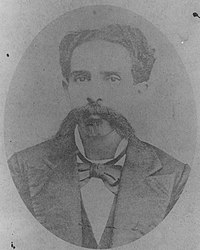Cesareo Guillermo
Cesareo Guillermo y Bastardo (born March 8, 1847 in Rodado, Hato Mayor , † November 8, 1885 in Azua ) was a Dominican general and President of the Dominican Republic .
biography
At the age of 16, Guillermo, who came from the province of Hato Mayor, entered the military in 1863 . In addition to his military career, he later began a political career, in the course of which he was a member of the National Congress (Congreso Nacional) and Minister of the Interior and Police (Ministro de Interior y Policía). Later he was commander of the armed forces in Higüey in the province of La Altagracia and was promoted to general as commander of the armed forces in the Cibao region . At that time, many cities lay in ruins after the Spanish occupation forces withdrew, and the Dominican Republic was divided among several dozen rulers. While the former counter-president José María Cabral controlled large parts of Barahona and the southwest with the help of the mahogany exporters close to Buenaventura Báez , Guillermo, who was now a cattle breeder, assembled a coalition of former Santanista generals in the southeast and Gregorio Luperón ruled the north coast.
From March 5 to July 7, 1878, he was President of the Central Government for the first time as President of the Dominican Republic . After a provisional revolutionary junta under Ignacio María González , he was next to Ulises Heureaux as commander-in-chief of the Unanimous People's Movement (Movimiento Unánime Populardesde) from September 2 to 6, 1878 again de facto president. After a nearly three-week interim government under Jacinto del Rosario de Castro, he became a member of the Council of State Secretaries on September 30, 1878, to which Alejandro Angulo Guridi and Pedro Ramón Aristy belonged. In this government he was interior, police, war and naval ministers and was therefore finally able to assert his power against Guridi and Aristy, so that he was president again between February 27 and December 9, 1879.
After a failed revolt, he fled to Jacmel in neighboring Haiti on January 24, 1882 . He later became one of the most staunch opponents of the presidencies of Alejandro Woss y Gil and Heureux, which became a dictatorship . For this reason he initiated together with the governor Juan de Vargas in Azua a revolution named after him against President Woss y Gil, the successor of Francesco Gregorio Billini . President Woss y Gil therefore ordered his arrest, which he escaped after fighting with government forces. Together with some other revolutionaries he went to Baní , where he planned the further action against the government. After he had to leave Baní because of the threat of arrest, he committed suicide on November 8, 1885 while fleeing government troops in the province of Azua, to which Ulises Heureaux, whose enemy he had been for many years, had fled. After his suicide, his body was buried in the municipal cemetery of Azua by order of the governor of Azua, Eugenio Generoso de Marchena.
A hundred years after his death, his body was exhumed at the instigation of his hometown and buried in Hato Mayor .
swell
- History of the Dominican Republic
- Homepage of the Ministry of Culture (National Archives)
- WIKIDOMINICANA
Individual evidence
- ↑ Presidentes dominicanos por provincias ( Memento of the original of March 23, 2009 in the Internet Archive ) Info: The archive link has been inserted automatically and has not yet been checked. Please check the original and archive link according to the instructions and then remove this notice.
- ↑ rulers.org
- ↑ Gobiernos: Restauración y Segunda República: 1863-1916
- ↑ , NEW YORK TIMES September 19 "SAN DOMINGO GOVERNMENT" 1879
- ↑ "THE WEST INDIES .; MOVEMENTS OF agitator - SAN DOMINGO'S REVISED CONSTITUTION - insurrections feared," New York Times on Feb. 14, 1882
- ^ Dominican Republic. ULISES HEUREAUX, 1882-99
| predecessor | Office | successor |
|---|---|---|
| Buenaventura Báez |
President of Dominik. Rep. 1878 - 1879 |
Gregorio Luperón |
| personal data | |
|---|---|
| SURNAME | Guillermo, Cesareo |
| ALTERNATIVE NAMES | Cesareo Guillermo y Bastardo |
| BRIEF DESCRIPTION | President of the Dominican Republic |
| DATE OF BIRTH | March 8, 1847 |
| PLACE OF BIRTH | Rodado, Hato Mayor |
| DATE OF DEATH | November 8, 1885 |
| Place of death | Azua |

